ASUS P5Q3 Deluxe: An Early Preview of P45 Express Performance
by Kris Boughton on May 13, 2008 2:00 PM EST- Posted in
- Motherboards
Board Layout and Features
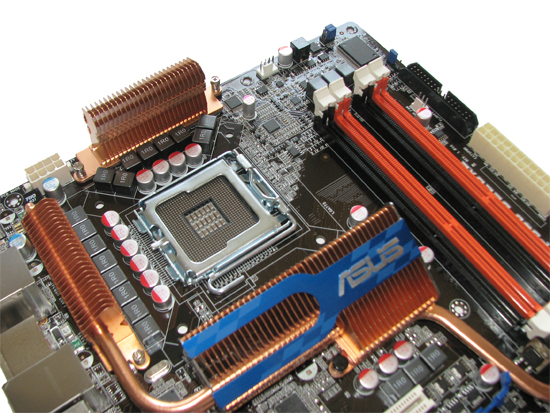
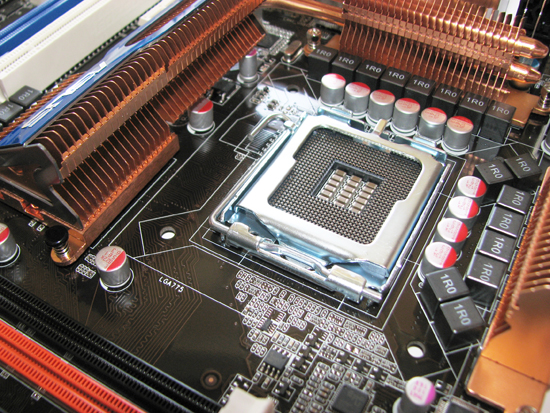


The P5Q3 may report the use of a 16-phase PWM but we know better. Although ASUS design engineers have added a lot of extra chokes and MOSFETS, the overall capacity of the power delivery circuit remains comparable to their competitors' more modest 8-phase designs. One thing's for certain, we can all agree that more phases do not necessarily make for a more stable power subsystem. Although we did not experience any problems with this particular solution we would rather see ASUS concentrate their efforts on designing an entirely new circuit based on a true 6-phase PWM.
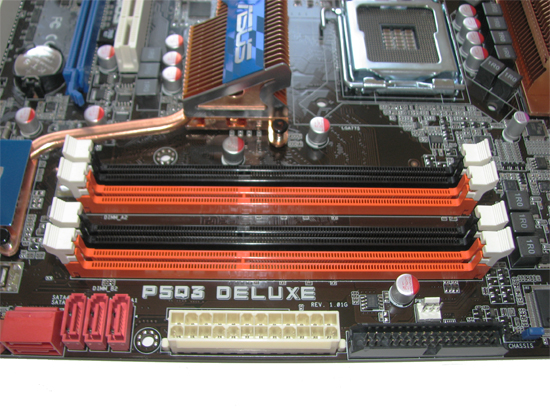
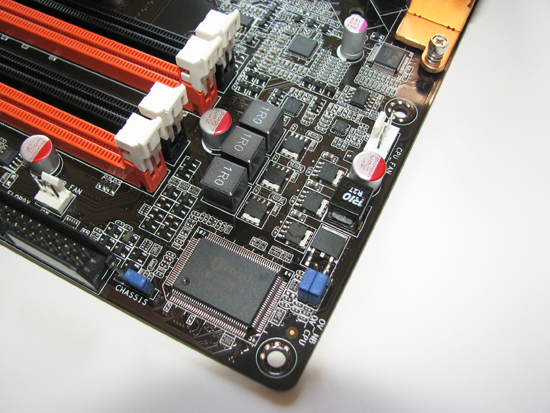
The DDR3 power circuit is a 3-phase design, just like the P5E3 Premium, and the board has no problems clocking memory to speeds of DDR3-2000 and higher. We recommend you place your modules in the orange slots first and populate the black slots only as needed. Because of the way DDR3 signals are terminated on the modules themselves, it is often possible to coax maximum speed from the system with the memory in this configuration.

The all-copper heatsink is both functional and aesthetically pleasing. ASUS was also wise to include back plates for the portions of the cooler covering the power MOSFETs and mounting screws to tightly secure the assembly to the board.
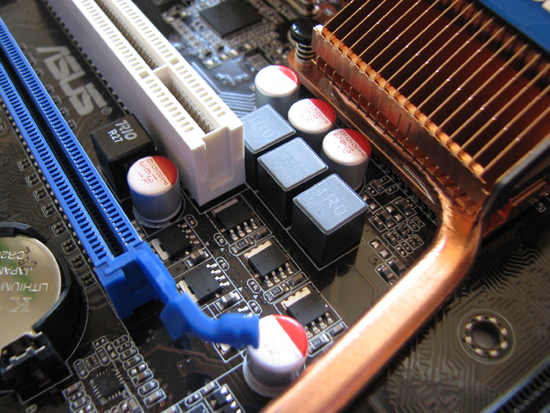
ASUS engineers have taken their MCH power delivery system one step further than before; the P5Q3 now features a 3-phase design whereas the P5E3 Premium used a 2-phase solution. Thanks to the relatively low power requirement of the MCH, active cooling is not necessary for any of these MOSFETs, although it could not hurt if you decided to customize your board by placing extra sinks on the hotter components.
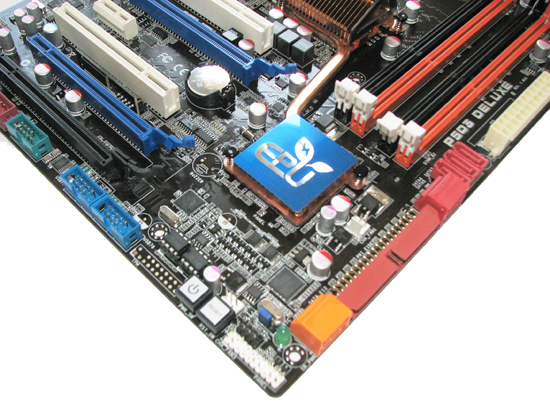
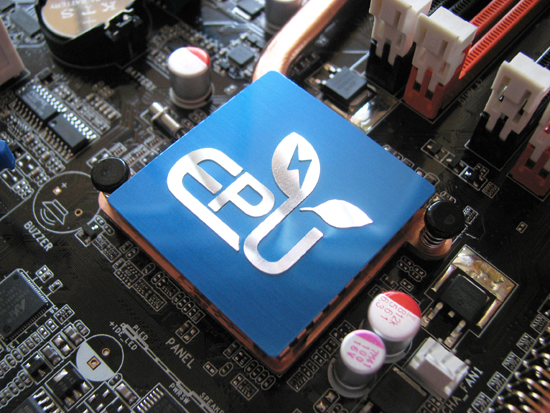
The five red SATA ports are electrically connected to the ICH10(R) Southbridge with the sixth present in eSATA form, located on the board's back panel. A JMicron JM363 host controller provides an additional two SATA ports (orange), capable of RAID 0, 1 and JBOD operation, as well as a single PATA port for legacy IDE hard disk or optical disc support. Integrated power and reset momentary tactile switches can been seen in the corner of the board. The lone green LED is the only indication that the board is powered - be sure to pay attention to the state of this light whenever removing or inserting any components.
The ICH10R is covered by a custom two-piece heatsink and is thermally coupled to the MCH and half the bank of CPU power MOSFETs via a single heatpipe. It would have made sense to include the other MOSFET cooler but the placement of the ATX12V+ power connector might have made this difficult. The cobalt blue cover is adorned with an artistic "EPU" logo and represents the incorporation of ASUS' Energy Processing Unit technology that seeks to maximize overall system power savings during periods of light CPU loading by selectively enabling and disabling power delivery phases for the most efficient operation possible. Our lab results show the savings to be small yet measurable.
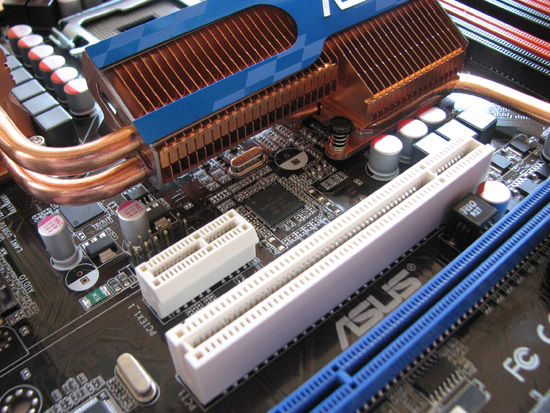
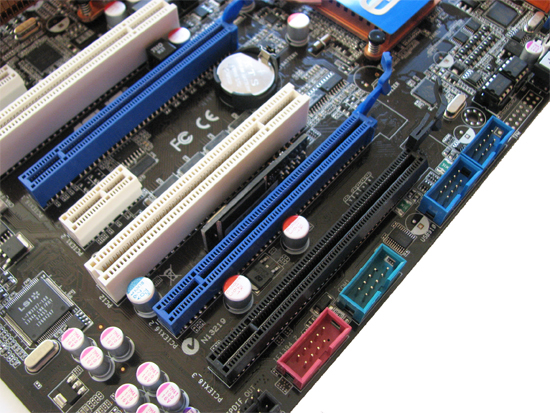
The P5Q3 Deluxe includes support for up to three PCIe x16 cards. The two blue slots are fully PCIe 2.0 compliant and hang off the P45 Northbridge. They can be configured for either 1x16 or 2x8 operation, depending on the number of cards installed. The bottom black slot is PCIe 1.x compatible only and is serviced by the ICH10R Southbridge. While the slot can mechanically seat x16 cards the maximum electrical connection is just x4 due to the lack of available lanes. For maximum performance, populate the blue slots before working with the last black one.
Two PCIe x1 slots (1.x compatible) and a pair of legacy PCI slots round out the board's expansion capabilities. Overall, we prefer the P5Q3 Deluxe expansion slot layout over that offered by the P5E3 Premium. Unlike the X48 board, this P45 board provides double spacing between the two primary PCIe 2.0 slots.










30 Comments
View All Comments
cuti7399 - Thursday, August 14, 2008 - link
is this true?957004 - Thursday, May 22, 2008 - link
so it mean i will no need to buy ASUS x48 MB?Narg - Monday, May 19, 2008 - link
$250 is way too much, especially for a low end chipset board. I just bought a board for $60 that does 100% of what I need for a new Vista-64 machine with Crossfire. The MB pricing has been going through the roof lately.kjboughton - Saturday, May 24, 2008 - link
We've just received an MSRP update direct from ASUS, expect to see this board selling for about $229 with the P5Q (DDR2) variant available for about $209.Nihility - Thursday, May 15, 2008 - link
the instant on technology Asus put on this thing?Some stripped down linux distro as I understand it
Egglick - Wednesday, May 14, 2008 - link
After looking things over with the P35 added to the mix, I'm going to be completely honest here -- the P45 at any substantial premium is a load of crap.By my calculations, the performance difference between a P35 and P45 is 2-3% at most, and the majority of the time you're only talking about tenths of a percent.
When you consider that P35 boards are selling for as low as $75 now (with several from Asus going for under $100), you'd have to be nuts to pay $225+ for a difference which is hardly even worth mentioning.
Sure, you can save anywhere from 7-19 watts with the P45 (depending on the application), but you can save twice that by replacing one of your light bulbs with a compact florescent. Spend your money elsewhere.
hpram99 - Wednesday, May 14, 2008 - link
"two RJ-45 1000GBps Ethernet ports"Oh my god! I must go out and buy a hundred of these, make a super switch out of them! That's incredible, are they going to do away with SATA now that Asus made Ethernet run 300x faster?
lopri - Wednesday, May 14, 2008 - link
Well, actually I wish ASUS (and other board makers) made their board with ONE Intel Gigabit PHY, instead of two or four Marvell PHY. Heck, get rid of that EPU BS while you're at it.hooflung - Wednesday, May 14, 2008 - link
I want to get excited. I really do. But as an owner of a Gigabyte P965 DS3 I just can't get aroused. My e4300 still is clocking strong at 3.0ghz. There isn't enough speed to justify going .45nm just to hit 3.8 - 4.0ghz and also having to go to DDR3. Even if they release a DDR2 board its likely is it going to be worth buying a new board or just installing a 'beta' bios on my current setup if I did want to get a .45nm chip.Just seems Intel wants to go out with a bang and also have more unload options for their C2Ds when they switch platforms within the next year.
If I was buying new, I'd be really tempted but good ol' faithful P965 is running 1 year strong on a mild OC 'according to today's standards of OCing.'
Stele - Wednesday, May 14, 2008 - link
[quote]The P5Q3 may report the use of a 16-phase PWM but we know better. [/quote]Do we, really?
[quote]Although ASUS design engineers have added a lot of extra chokes and MOSFETS, the overall capacity of the power delivery circuit remains comparable to their competitors' more modest 8-phase designs.[/quote]
From the review we don't know what components Asus used in its PWM design (MOSFETs, drivers etc) - heck, we don't even know what PWM controller they have there. It could be the same ADP3198 4-phase controller Asus had been using for some time, or it could be a newer, improved one - especially considering that Analog transferred much of its CPU PWM controller range to ON Semiconductor late last year.
We don't have figures from Asus engineers. We also did not examine the circuitry's layout, overally efficiency, transient response, peak and sustained load-handling capabilities ... nothing of the sort, yet we're prepared to come to a positive conclusion regarding the capabilities and quality of the circuitry, and indeed compare it with others. An educated guess, based on some evidence to back it up, would've probably been more appropriate. IMHO it's not exactly fair (or professional) to jump to such a conclusion with merely an assertion without any substantiation to support it. That's expected from readers who can only look at the product and play the armchair general, but not from reviewers who actually have the product and can (and should) do what they can to properly assess it for the benefit of said readers.
As for the rest of the review, it was certainly interesting; however correct me if I'm wrong, but it seems that ICH10/R is supposed to bring rather more to the table than just 2 more SATA ports plus AHCI capabilities for the non-R version. For instance, apparently a 10GbE MAC is integrated as well.
However, as with the ICH9's integrated GbE MAC, many manufacturers may balk at having to use specific (particularly, i8256x) Intel PHYs in order to make use of that MAC, since it requires a PHY that supports Intel's GLCI/LCI bus. Instead, manufacturers may choose to provide the usual PCIe/PCI controllers that they've normally been using, to keep inventory and costs under control (such controllers can be used on AMD platform products, for example). Perhaps the same proprietary-PHY issues might plague implementation of ICH10's rumoured Wi-Fi capabilities as well... all in all, then, it does seem that as far as the end user of actual motherboard products is concerned, there would apparently be very little that's new with the ICH10. IMHO, Intel could've added more PCIe lanes, which would probably have been better appreciated.
Speaking of PCIe lanes, that's probably one reason Asus chose to stick with USB for the wireless module. USB does the job well enough - if it ain't broken, why fix it? PCIe x1 is overkill and ICH10 is already in dire shortage of lanes, with 1 going to network (2 for dual-NIC motherboards), 1 or 2 going to PCIe x1 slots and just 4 left to go to the third graphics card x16 slot. With the abundance of USB ports that ICH9 and 10 provide, Asus probably figured that using one for the wireless module can't hurt. And if anything it's probably to do with inventory and ease of design as well, since Asus does make wireless USB adapters - you could use the same basic circuit design and fit it with a motherboard USB connector and external antenna interface - voila, wireless for motherboards.
At least Anandtech did not help perpetuate the unconfirmed (and unlikely) rumour that ICH10 eliminates legacy ports like PS/2, parallel, serial, game/MIDI and so on - since those ports have little to do with the south bridge at all. These legacy ports connect to Super I/O chips, which on modern motherboards is also the H/W monitoring IC, and which in turn connect to the south bridge via the LPC interface. Thus the only way an ICH could completely remove support for legacy ports in current motherboard architectures would be to remove the LPC bus - which would also remove H/W monitoring as well as BIOS, unless it's part of Intel's force-forward plan to move to SPI for BIOS, a la RDRAM and PATA. That still leaves H/W monitoring high and dry though.
On another note, as others here (especially Frumious1) have commented, it would be good to compared Intel chipsets from, say, P965 through P45 to see what improvements P45 brings. Perhaps some useful metrics would be performance tests for memory (read/write/copy/latency/overclockability), CrossFire (x8,x8 on P45 vs x8,x8 using a PCIe switch IC vs 16,x4 etc), disk and USB subsystems (read/write/copy/copy across ports), power consumption. Oh and please have all the tested boards participate in all tests, so that there's a complete comparison across the board.
Admittedly, power consumption is the trickiest of them all because each generation of motherboards have different components and/or different features (e.g. one has FireWire while another doesn't, or one uses a FireWire controller from Agere while another uses one from VIA etc). Perhaps we could try disabling all such external controllers in BIOS and seeing if that makes a difference to power consumption (ie whether the option turns the controllers off or merely disconnects them) then, if turning them off does work, test the boards with all external options disabled. That, at least, minimises variables to board layout and CPU/MCH/ICH/RAM power circuitry subsystems - which would be useful metrics themselves. Just a suggestion!